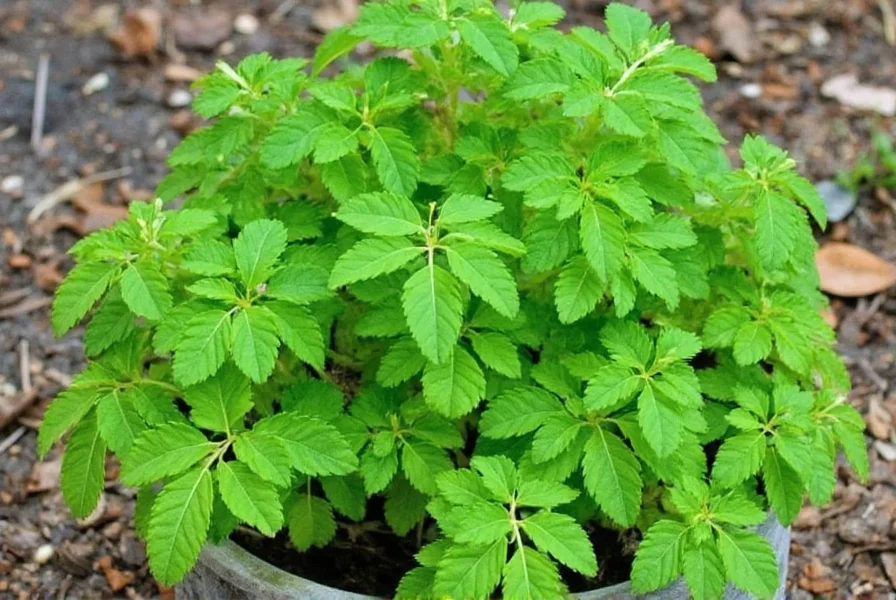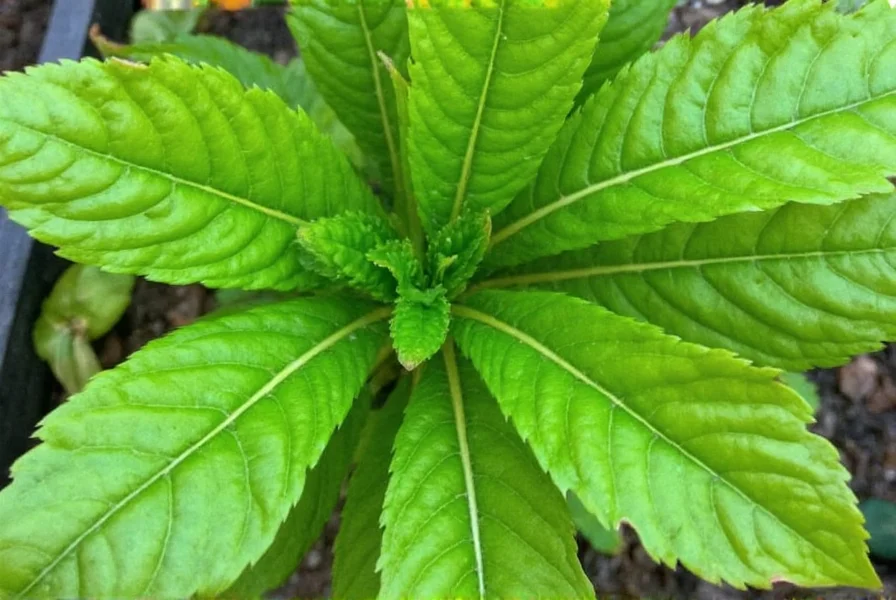Vietnamese coriander stands as one of the most resilient and flavorful herbs for tropical and subtropical gardens. This hardy perennial thrives where traditional cilantro fails, making it an essential addition for gardeners seeking reliable culinary herbs in warm climates. Understanding its unique characteristics helps both novice and experienced gardeners incorporate this valuable plant into their herb collection.
Identifying Vietnamese Coriander: Key Characteristics
Vietnamese coriander features lance-shaped leaves with distinctive pink veins running diagonally across the surface. The leaves grow in a rosette pattern from a central stem, reaching 6-12 inches in height. Unlike cilantro, which produces delicate, lacy leaves, Vietnamese coriander has thicker, more substantial foliage with a slightly fuzzy texture.
The flavor profile delivers a more intense, peppery version of cilantro with subtle notes of ginger and mild heat. This characteristic makes it particularly valuable in Southeast Asian cuisine, where it appears in dishes like Vietnamese pho, Malaysian laksa, and Thai salads. When crushed, the leaves release a potent aroma that remains stable even when cooked—unlike regular coriander, which loses flavor with heat.
| Characteristic | Vietnamese Coriander | Regular Cilantro |
|---|---|---|
| Botanical Family | Polygonaceae | Apiaceae |
| Heat Tolerance | Excellent (thrives in heat) | Poor (bolts quickly) |
| Flavor Stability | Maintains flavor when cooked | Loses flavor with cooking |
| Lifespan | Perennial | Annual |
| Leaf Texture | Thicker, slightly fuzzy | Delicate, lacy |
Growing Vietnamese Coriander Successfully
Successful cultivation of vietnamese coriander plants requires attention to specific growing conditions that maximize their potential. This herb prefers partial shade in hot climates but tolerates full sun in cooler regions. The ideal temperature range spans 65-85°F (18-29°C), though established plants withstand brief periods outside this range.
For optimal vietnamese coriander care, maintain consistently moist but well-draining soil. A mix of 60% potting soil and 40% perlite works well for container growing. Regular harvesting encourages bushier growth—simply snip stems just above a leaf node using clean scissors. During peak growing season, apply a balanced liquid fertilizer every 4-6 weeks to maintain vigorous growth.
Propagation proves remarkably simple with vietnamese coriander plants. Take 4-6 inch stem cuttings, remove lower leaves, and place in water until roots develop (typically 7-10 days). Alternatively, divide established clumps during spring for instant mature plants. Gardeners in USDA zones 7-11 can grow this herb outdoors year-round, while colder climate gardeners should bring potted plants indoors before first frost.

Culinary Applications and Substitution Guidelines
Vietnamese coriander's culinary versatility makes it indispensable in many Southeast Asian kitchens. Use fresh leaves as a garnish for pho, add to spring rolls, or incorporate into dipping sauces. The herb holds up remarkably well in cooked dishes—unlike regular cilantro—which explains its prevalence in hot soups and stews.
When substituting vietnamese coriander for regular coriander in recipes, use a 1:1 ratio for raw applications. For cooked dishes requiring cilantro, you'll need only half the amount of vietnamese coriander due to its more intense flavor. The stems remain tender enough to use entirely, reducing food waste compared to traditional coriander where only leaves typically get used.
Preserve excess harvest by freezing whole leaves in ice cube trays with water or oil. Drying proves less effective as it diminishes the distinctive flavor profile. For gardeners seeking reliable herbs for hot climates, mastering vietnamese coriander cultivation techniques ensures year-round access to this valuable culinary resource.
Troubleshooting Common Growing Challenges
Yellowing leaves often indicate overwatering—a common mistake when caring for vietnamese coriander plants. Allow the top inch of soil to dry between waterings. If leaves develop brown edges, increase humidity around the plant or provide more shade during peak afternoon sun.
While generally pest-resistant, aphids occasionally target new growth. Combat infestations with a gentle spray of soapy water or neem oil solution. Leggy growth signals insufficient light—move container plants to brighter locations or prune back to encourage bushier development.
During winter months, growth naturally slows. Reduce watering frequency and suspend fertilization until spring returns. Container-grown plants benefit from being moved to a protected location when temperatures drop below 50°F (10°C).

Practical Applications Beyond the Kitchen
Beyond its culinary value, vietnamese coriander demonstrates impressive versatility. Traditional medicine systems utilize the herb for digestive support and minor wound treatment. The leaves contain compounds with antioxidant properties that continue to attract research interest.
Gardeners appreciate its ability to thrive in challenging conditions where other herbs fail. Its dense growth habit makes an attractive border plant, and the small white flowers attract beneficial insects to the garden. For urban gardeners with limited space, vietnamese coriander proves ideal for container gardening on balconies or windowsills.
Conclusion: Maximizing Your Vietnamese Coriander Experience
Understanding the unique requirements of vietnamese coriander plants transforms gardening success in warm climates. By implementing proper vietnamese coriander care techniques and recognizing its culinary advantages over traditional cilantro, gardeners gain access to a reliable, flavorful herb that enhances both garden and kitchen. Whether you're growing your first herb or expanding an established collection, this resilient plant deserves consideration for its unmatched heat tolerance and distinctive flavor profile.
Frequently Asked Questions
Can Vietnamese coriander survive winter outdoors?
Vietnamese coriander survives outdoors year-round in USDA zones 7-11. In colder climates (zones 6 and below), gardeners should bring potted plants indoors before first frost. The plant goes dormant when exposed to freezing temperatures but typically regrows from roots when temperatures rise in spring.
How does Vietnamese coriander differ from regular cilantro in cooking?
Vietnamese coriander maintains its flavor when cooked, unlike regular cilantro which loses potency with heat. It has a stronger, more peppery taste with subtle ginger notes. When substituting in cooked dishes, use half the amount of Vietnamese coriander compared to regular cilantro due to its more intense flavor profile.
Why does my Vietnamese coriander keep dying?
Common causes include overwatering (leading to yellow leaves), insufficient humidity (causing brown leaf edges), or too much direct sun in hot climates. Vietnamese coriander prefers consistently moist but well-draining soil, partial shade in hot regions, and protection from intense afternoon sun. Check for proper drainage and adjust watering frequency based on soil moisture.
Can I grow Vietnamese coriander indoors?
Yes, Vietnamese coriander grows well indoors with proper care. Place in a bright window receiving 4-6 hours of indirect sunlight daily, maintain consistent moisture without waterlogging, and provide humidity through misting or a pebble tray. Indoor plants benefit from monthly balanced liquid fertilizer during growing season and regular harvesting to encourage bushy growth.
How often should I harvest Vietnamese coriander?
Harvest Vietnamese coriander every 2-3 weeks during active growing season to encourage bushier growth. Always cut just above a leaf node, removing no more than one-third of the plant at a time. Regular harvesting prevents the plant from becoming leggy and promotes continuous production of fresh, flavorful leaves throughout the year.











 浙公网安备
33010002000092号
浙公网安备
33010002000092号 浙B2-20120091-4
浙B2-20120091-4